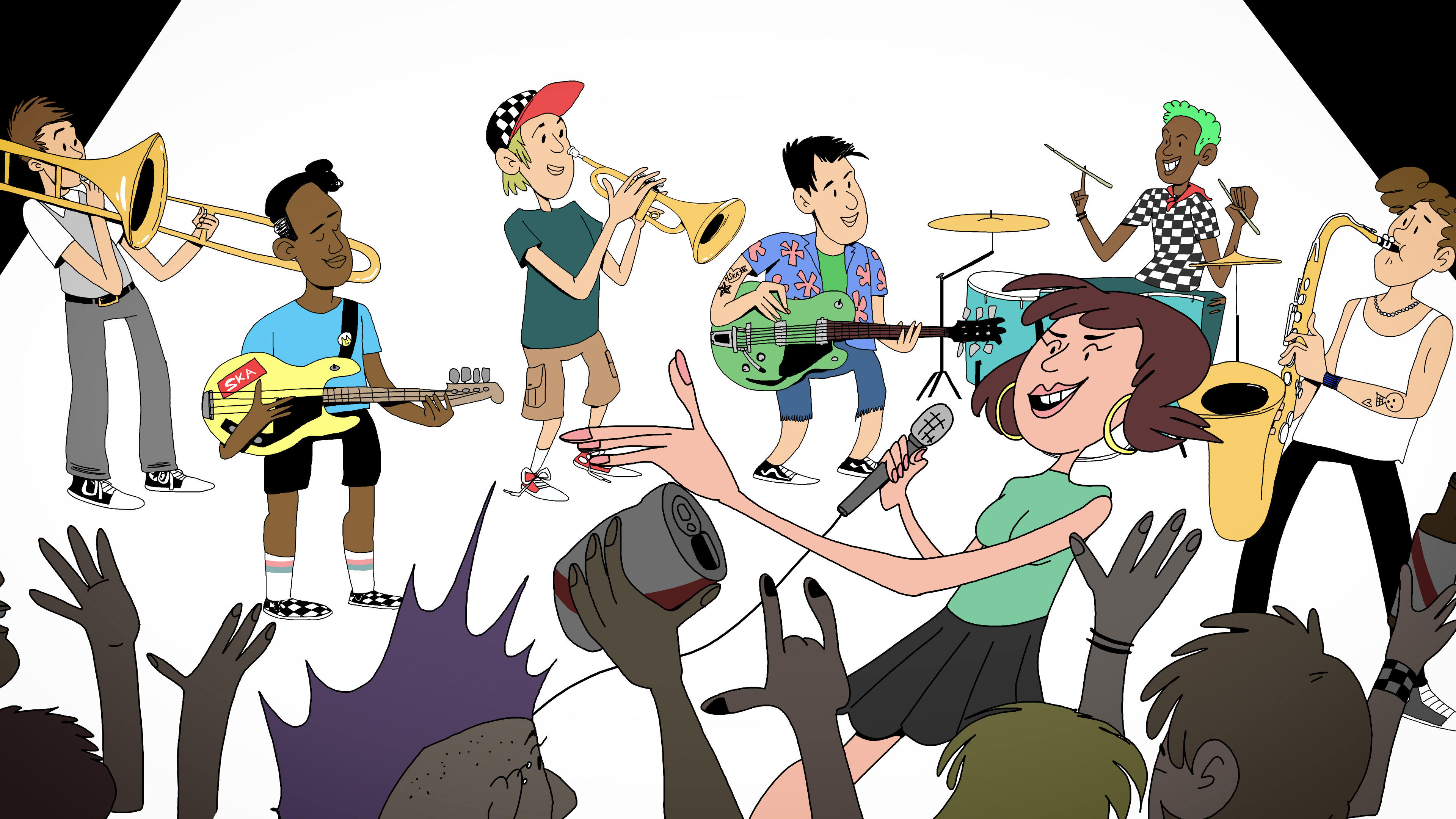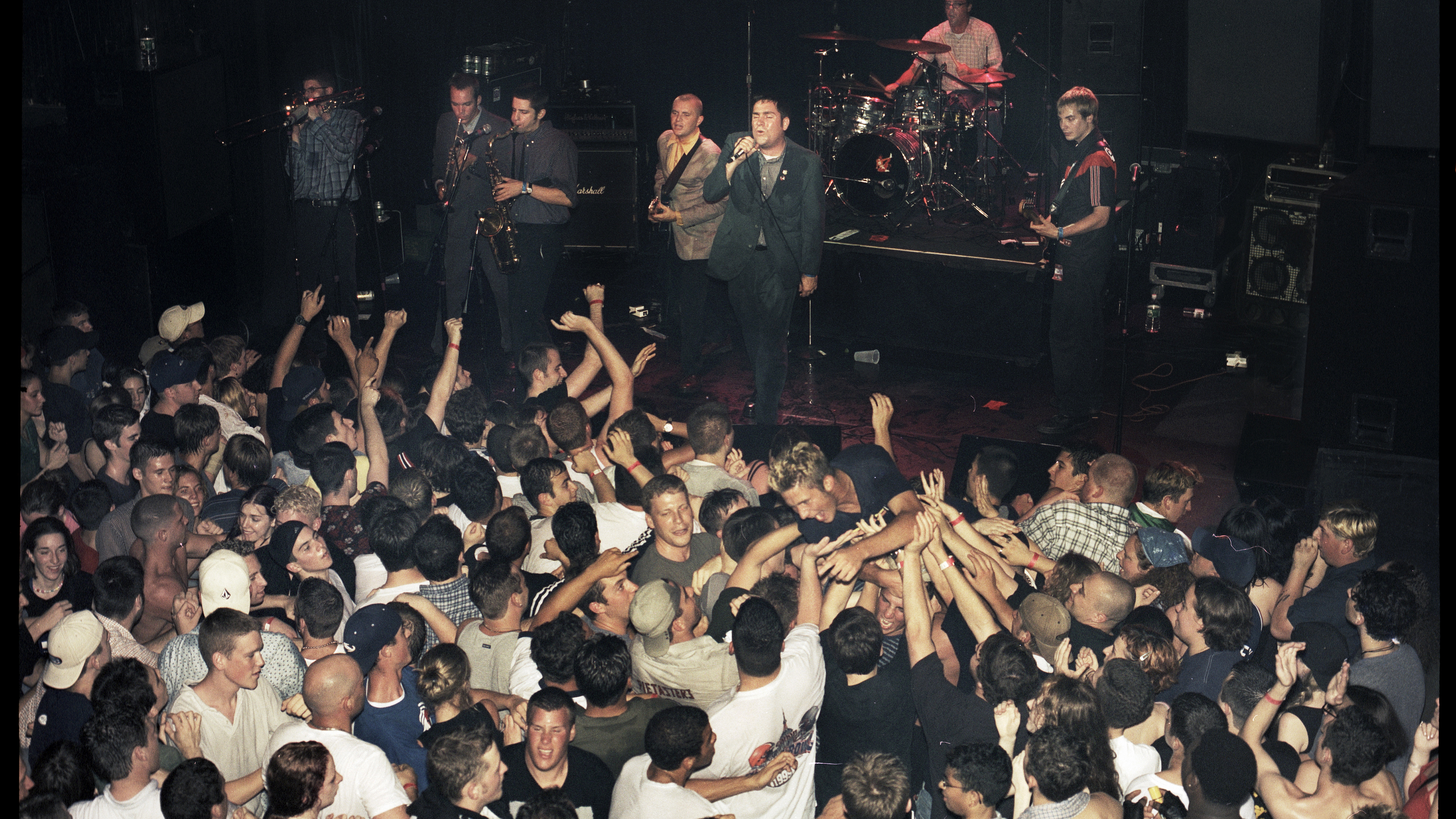Taylor Morden’s ska-doc shows it’s never too late to “Pick It Up!”

Image courtesy of Popmotion Pictures
Considering the contrast between the seemingly niche qualities of late 20th century third wave ska, as well as its weight of impact as a beacon of equal parts loved and puzzlingly mocked music and subculture, the thought of trying to present this style’s significance and history in time-constrained documentary Pick It Up!: Ska in the 90s, seems like a convoluted task – one that’s destined for getting lost in historical translation. Nevertheless, despite the nearly Valentine’s Day–level density of third wave ska heavy-hitters brought aboard for context, commentary, anecdotes, and humor, the roughly hour and 35 minute film manages to straddle star appeal, knowledgeable value, and approachable delivery with the astuteness of a well written brass hook.
Even for the well-initiated of third wave ska, the first daunting questions surrounding this doc would likely hover around how much and how thoroughly ska’s incredibly diverse explosion in the 90s could be addressed. Well, from the cold opening first few minutes, which wastes no time getting a good swath of ska musicians to paint two strokes of the picture that ska in the 90s was, Morden shows an aspiration for balance. First hand artist nostalgia: check. Historical explanations dubbed over flashes of old concert footage, promotional images, and cheesy pop-culture references check. Wrap the opening with a lightheartedly apologetic declaration by Matt “Mojo” Morginsky of the O.C. Supertones wherein he says, “Blame us why don’t you? Just come out at say it! It’s Orange County’s fault that ska crashed! Yes, [Orange County] overdid it. Are you happy now?” and Pick It Up! presents an introduction that projects the overall fun, quirky, and easy-going character of the film while summarizing its intended chronological capsule with the curiosity-fueling quality of a well-written abstract.
As the film carries on, the use of animation to emphasize the uniqueness of an anecdote or a person in the film’s overall narrative, feels akin to the approach of underappreciated contemporary work like that from PBS’s “Blank on Blank” interview series.

Image courtesy of Popmotion Pictures | Design Credit: Steve Vance
While not explained outright by narrator Tim Armstrong (of Rancid) as he lays out the origins of ska, the style’s historically well-dressed, technically skilled, and formally gathered roots interestingly contradict with its iteration in the 1990s. Though ska is presented as appealing to anyone who will listen, the third wave transformed into a subculture that shed its formal, Rude Boys-originating appearances in favor of offbeat, colorful, and casual attire in the audiences and fan communities. This aesthetic more closely aligned with ska’s fundamental party-anywhere-and-with-anyone vibe than even early stage Two-Tone style born from ska’s fusion with English punk and R&B dress, did. The bit of retrospective here, that proceeds to move toward Pick It Up’s examination of 90s third wave, speaks to a strength of the film as a whole: it educates with memorable flair, without compromising the sometimes smaller but no less important details of transitional milestones in ska’s evolution.
In truth, the candor of many artists on topics that ranged from the thesis-like starter of, “What is ska?” (cue many versions of “upbeat reggae,” when in fact ska preceded the latter), to the proposal by Ska: An Oral History author, Heather Augustyn, that after grunge, “…we needed something to make up feel better,” is perhaps what helps propel the film’s recollection more than just the artists’ opinions at any given moment, which could be presumed to push the film forward from sheer star-power. Herein lies another strength of the film: hearing the nuances of howall these artists, friends, managers, writers, and family members thought of ska’s place in the world during the 90s, rather than just the verdict of they had to say. The subtle but crucial different speaks to what it means for average folk to be engaged with a story or a feeling rather than simply receiving it.

The Piestasters Live | Image courtesy of Popmotion Pictures
Sarcastically self-depreciating one-liners affirming that horn players are still nerds, even if ska put them front and center on MTV, let viewers feel like they’re being let into the ska club. And yet, in the same breath, we’re brought back to an informative recollection and present day reaction to the emergence of third wave subcultural elements. Things like the unspoken omnipresence of that one guy with a Hawaiian shirt in ska band lineups, get a moment of grounding in reality – albeit semi-ridiculous reality – rather than remaining a silently acknowledged, urban legend-like stereotype.
The film isn’t all sunshine and rainbows though, which serves as a reminder that Pick It Up isn’t set behind rose-colored glasses, even if the soul of the genre was pushing for unity and acceptance. Artists touch on their observances of elitist surges between fans of ska’s various waves, as well as discuss how their respective bands felt about the unfortunate realities of pro-Nazi skinheads surfacing at shows only to cause trouble, stir up fights, and demean the atmosphere.
It’s only after all this historical foundation, airing of grievances, addressing of stereotypes, and tracing of the track that brought third wave ska to its acme in the 90s, that the documentary’s tone manages to relax even more as the heavy hitters alluded to at the beginning – Reel Big Fish, No Doubt, Save Ferris, The Specials, and more – get time in the spotlight with no complicated anecdotes floating in the margins. The back portion of the film is like the ride on a roller coaster after climbing to the top. The initial rise is part of the fun and riders can enjoy the view and the anticipation waiting for the peak. Yet, the sheer kinetic momentum and unstoppable movement – much like what third wave in the 90s was – is the part where the riders (in this case, the audience,) can throw their hands up, lean back, and soak up every ounce of nostalgia about how these bands blew up and then flew up like a puff of smoke once the sharper tones of nu-metal, and horn-less intensity of emo started to form in the early 2000s (and yes, that rush of nostalgia includes a Tony Hawk’s Pro Skater reference – and one particular musician’s story of his fixation literally mid-show).
Pick It Up takes a serious dive into the slightly odd chameleon that ska music was and presents that plethora of meticulously gathered information with a multimedia approach that is about as diverse, unexpected, entertaining, and slightly difficult to pin down, as ska itself. It looks like it was all fun, games, and simply something a knowledgable enthusiast that happens to know how to direct, put together. But just as the over zealous record executives of the 90s obsessed over ska’s goofy and loose energy without recognizing the white knuckled dedication and work that went into the music as well, don’t underestimate what this film offers – even for the most sharply dressed, trumpet obsessed, skanking best, out there.
Pick It Up is available now on Blu-ray, DVD, and digitally.
Get the film, as well as other merch bundles direct from PopMotion Pictures HERE.

Leave a Reply